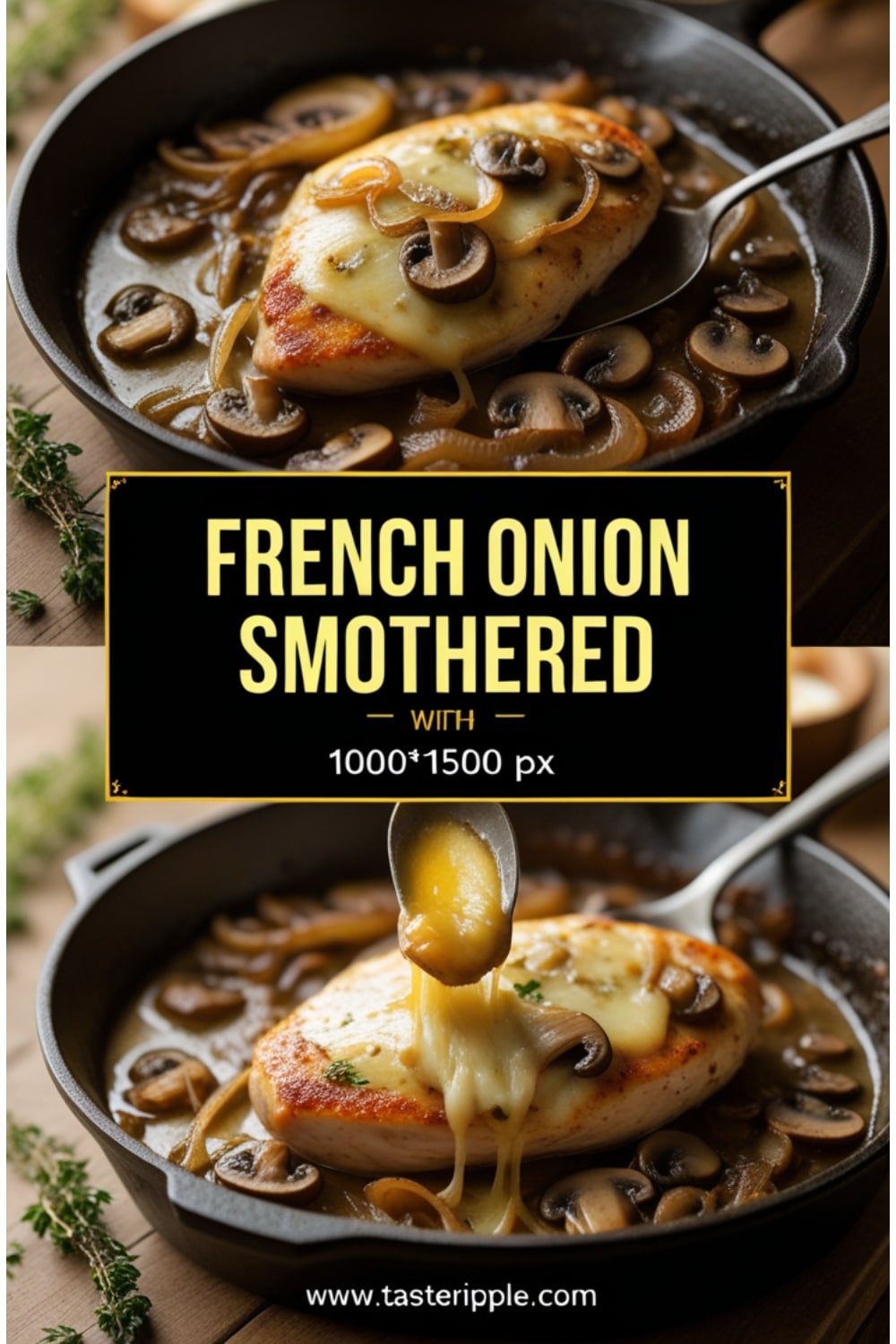The first time I made this dish, I nearly burnt the onions. My pan was too hot, my patience too thin. But I learned quick—slow coaxing turns ordinary onions into molten strands of gold. That moment made me realize this recipe is not about rushing, it’s about surrendering to time.
French Onion Smothered Chicken with Mushrooms is more than just a comforting skillet meal. It’s a marriage between the elegance of French onion soup and the rustic earthiness of pan-seared chicken. Mushrooms slip in to deepen the umami, and melted cheese drapes over everything like a warm blanket. The result is food that feels both old-world and modern, both rustic bistro and homey kitchen table.
What makes it special is the layering of flavors. Onions that are pushed right to the edge of sweetness. Mushrooms that release their juices and then brown. Chicken seared until its edges crackle, then slowly smothered in broth, wine, and melted Gruyère. Every bite is a lesson in balance—sweetness, savoriness, richness, and that gentle acidity that keeps you coming back for one more forkful.
Ingredients and Substitutions
Cooking this dish begins with building blocks. Each ingredient brings a distinct role, and swapping recklessly will cost you flavor. But done wisely, substitutions can be smooth and still keep the dish intact.
Here’s a clean table for the main ingredients:
| Ingredient | Measurement | Notes / Substitutions |
|---|---|---|
| Boneless, skinless chicken breasts | 4 medium (about 2 lbs) | Can use thighs for juicier meat |
| Yellow onions | 3 large (about 1.5 lbs) | Sweet onions work too; red onions change flavor |
| Mushrooms (cremini or button) | 12 oz, sliced | Shiitake or portobello for earthier tones |
| Olive oil | 3 tbsp | Butter for richness, avocado oil for high heat |
| Unsalted butter | 3 tbsp | Adds depth; ghee works for lactose-free |
| Garlic cloves | 3, minced | Roasted garlic for sweeter flavor |
| Beef broth (low sodium) | 2 cups | Chicken broth or mushroom broth can sub |
| Dry white wine | ½ cup | Optional but key for acidity; apple cider as non-alc option |
| Fresh thyme | 4–5 sprigs | Dried thyme (1 tsp) if fresh unavailable |
| Bay leaf | 1 | Optional but adds dimension |
| Gruyère cheese, shredded | 1 ½ cups | Swiss, provolone, or mozzarella as subs |
| Salt | To taste | Kosher salt preferred for control |
| Black pepper | To taste | Fresh ground for aroma |
| All-purpose flour | 1 tbsp | Thickens sauce; cornstarch for GF |
Insights on Ingredient Choices
Onions—always use fresh, not pre-chopped. Pre-cut onions lose their volatile oils and end up flat. Yellow onions have that perfect balance of bite and sweetness, making them ideal for caramelization.
Mushrooms—cremini are meaty but not overpowering. White button mushrooms are mild, but they won’t deliver the same earthy punch. If you want a luxurious flavor, shiitake or portobello can make the sauce feel richer, almost like velvet.
Gruyère—this is the soul of the smothering. It melts creamy but holds its body, giving that stretch and nutty sharpness. Mozzarella will melt gooey but lacks the depth. Swiss is closer but milder.
Chicken—breasts are classic, but thighs stay juicier and can stand up to longer cooking without drying. For professionals plating in restaurants, thighs also give more consistent texture when holding for service.
Step-by-Step Instructions
This recipe is not difficult, but it demands attention. Each stage builds on the last, and missing one detail—like rushing the onions—will ripple through the dish.
Step 1: Caramelize the Onions
Heat 2 tbsp olive oil and 2 tbsp butter in a wide skillet over medium-low. Add the sliced onions with a pinch of salt. Stir, then leave them alone. Caramelization happens slower than your impatience allows—30 to 40 minutes, stirring only when necessary.
Expert Tip: If onions start browning too quick, lower the heat and splash a tablespoon of water or wine. This rescues them and prevents burning.
Mistake to Avoid: High heat will fry them instead of caramelizing. They’ll taste bitter and ruin the sauce.
Step 2: Add Garlic and Mushrooms
Once onions are deep golden, add garlic and mushrooms. Increase heat to medium and cook until mushrooms release their water, then brown. This concentrates their flavor instead of steaming them.
Variation: For more intense umami, add a splash of soy sauce or Worcestershire at this stage.
Step 3: Deglaze with Wine
Pour in white wine, scraping the pan bottom. Every browned speck is flavor gold. Reduce wine by half—about 3 minutes—so the alcohol burns off and leaves just acidity and complexity.
Step 4: Build the Sauce
Sprinkle flour over the mixture and stir. This creates a roux-like base. Slowly add beef broth, whisking so no lumps form. Add thyme and bay leaf. Simmer 10 minutes until sauce thickens slightly.
Step 5: Sear the Chicken
In a separate pan, heat remaining oil and butter. Season chicken with salt and pepper, then sear each side until golden brown, about 3–4 minutes per side. Don’t worry if it’s not cooked through—it’ll finish in the sauce.
Pro Tip: Don’t overcrowd the pan. Overlapping chicken steams, not sears.
Step 6: Smother and Bake
Transfer chicken into the onion-mushroom sauce. Spoon some sauce over the chicken. Cover skillet and bake at 375°F for 20 minutes until chicken is cooked through.
Step 7: Cheese Blanket
Remove thyme and bay leaf. Sprinkle Gruyère over chicken. Broil 2–3 minutes until cheese bubbles and browns at edges.
Variation: Add a pinch of cayenne or smoked paprika under the cheese for heat and smokiness.
Cooking Techniques & Science
Caramelization is not just browning—it’s sugar molecules breaking down and reforming into hundreds of aromatic compounds. This is why caramelized onions taste both sweet and savory. They’re basically edible perfume.
Deglazing pulls the fond—those browned bits—from the pan surface into the sauce. Without deglazing, you’re throwing away pure concentrated flavor. Wine is classic because its acidity balances the sweetness of onions and richness of cheese.
Searing chicken first is about Maillard reaction. Amino acids meet heat, and a crust forms, locking in not “juices” exactly but creating a barrier of flavor that makes the chicken feel more succulent.
Storage and Reheating
Store leftovers in an airtight container up to 3 days. Reheat gently in a skillet with a splash of broth to loosen the sauce. Avoid microwaving directly—it makes the cheese rubbery.
For freezing: skip the cheese layer, freeze chicken with sauce, then reheat and add fresh cheese when serving.
Variations and Substitutions
- Gluten-free: Use cornstarch instead of flour to thicken.
- Vegan: Swap chicken with seared cauliflower steaks or portobello mushrooms, use veg broth, and top with vegan cheese.
- Spicy: Stir in chili flakes with the onions or finish with a drizzle of Calabrian chili oil.
- Low-carb: Serve without starch sides, maybe with cauliflower mash.
Tools That Matter
A wide heavy skillet is essential for onions—crowded pans steam, not caramelize. Cast iron or stainless works better than nonstick here. A broiler-safe skillet (like enameled cast iron) lets you go from stovetop to oven without fuss.
A sharp knife makes uniform onion slices, which means even cooking. Uneven slices burn before others caramelize.
Serving and Pairing Suggestions
Serve the chicken straight from the skillet—it looks rustic, family-style, inviting. For plating in a professional setting, spoon sauce under the chicken first, then rest chicken on top, letting cheese cascade slightly.
Pairings:
- Side dishes: Creamy mashed potatoes, buttered noodles, or crusty baguette to mop the sauce.
- Salads: Light arugula salad with lemon vinaigrette to cut richness.
- Drinks: A crisp Chardonnay balances creaminess. A light Pinot Noir complements mushrooms without overpowering.
Best Time to Serve
This dish shines on cool evenings when comfort is required. It’s hearty but not overwhelming, making it ideal for autumn or winter menus. Yet it also works for dinner parties because it carries that French bistro elegance. Serve when you want to impress but still feed generously.
Conclusion
French Onion Smothered Chicken with Mushrooms is not a 20-minute dinner. It asks for time, patience, a little surrender. But the payoff—sweet onions, rich sauce, tender chicken, bubbling cheese—is pure satisfaction.
Key tip: respect the onions. Burn them and everything collapses. Treat them with patience, and the dish transforms into a layered, deeply flavored experience. Professionals know—sometimes the difference between good and unforgettable is 10 extra minutes of slow cooking.
It’s a recipe that teaches as much as it feeds. It teaches restraint, attention, and the art of coaxing flavor instead of forcing it.
FAQs
Can I use chicken thighs instead of breasts?
Yes, thighs actually stay juicier and give a richer flavor. Just adjust cooking time slightly longer.
What cheese works best besides Gruyère?
Swiss or provolone works well. Mozzarella melts beautifully but is milder. For sharper flavor, use a mix of Gruyère and Parmesan.
Do I need the wine?
It’s optional, but it adds acidity that balances richness. If avoiding alcohol, use apple cider or extra broth with a splash of vinegar.
Can I make this ahead?
Yes, you can make the sauce and onions a day ahead, then reheat, add chicken, and finish with cheese when ready to serve.
Why is my sauce too thin?
Likely not enough reduction. Simmer longer or add a cornstarch slurry to thicken.

